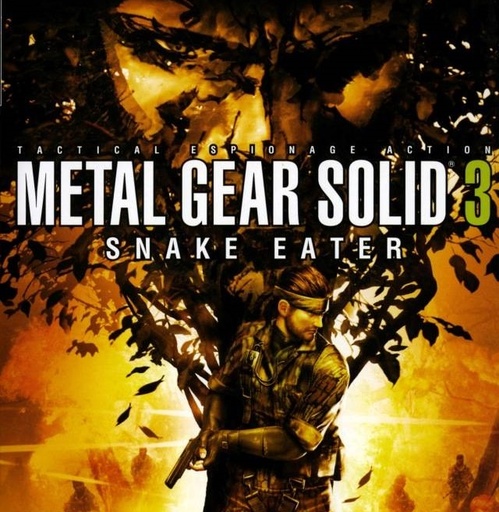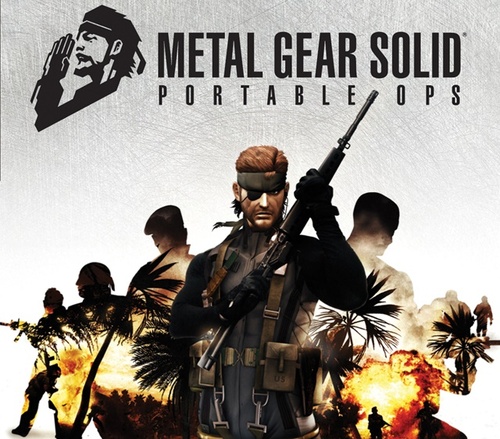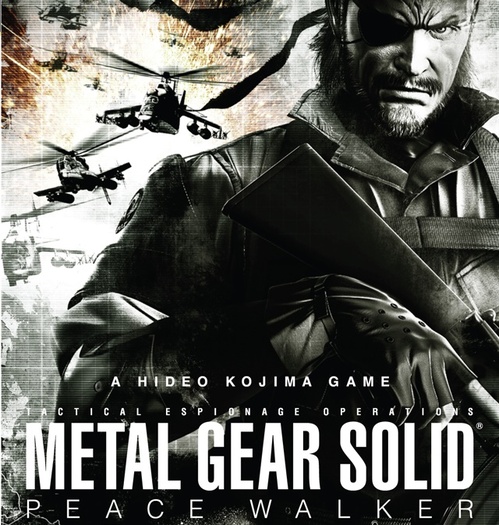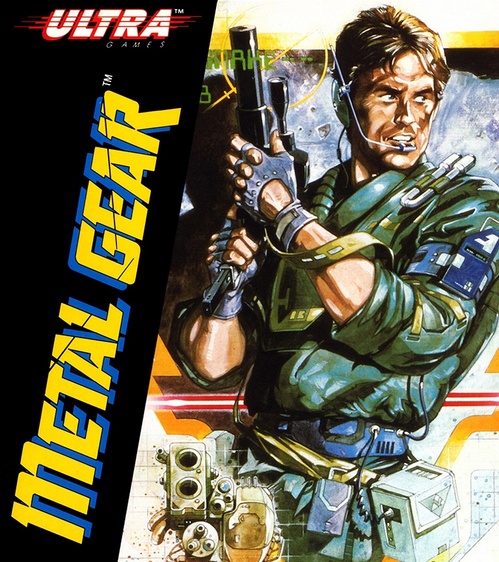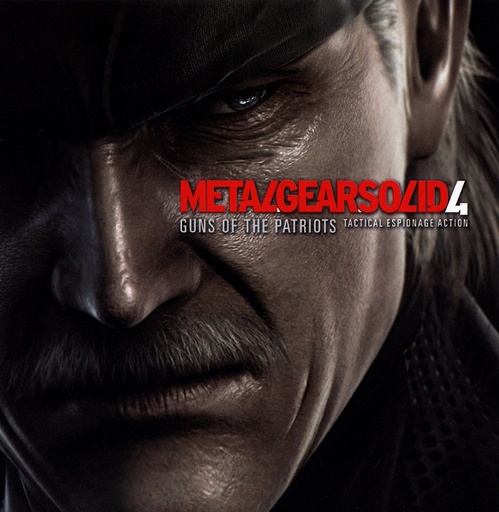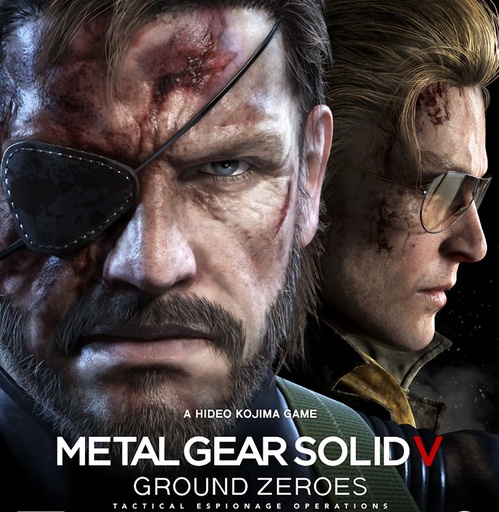Solid History: A Metal Gear Primer
Today Konami released Hideo Kojima’s Metal Gear Solid V: The Phantom Pain, the first numbered installment of the Metal Gear Solid series since 2008’s Metal Gear Solid IV. For the unaware, Metal Gear Solid is one of the most idiosyncratic franchises in videogames. Kojima has been designing Metal Gear games since the ‘80s, and has injected his creation with an insane amount of content. On the surface Metal Gear is just a stealth action game with some pulp-ish flavor, but the Metal Gear lore goes very, very deep. It’s populated with bizarre, enduring characters. Along with the rugged superspies Solid Snake and Big Boss you’ve got rogues like the mind-reading Psycho Mantis or the 100-year-old deadshot sniper The End. The Metal Gear universe is melodramatic, convoluted, crazily verbose, silly and horny, and that all makes it pretty wonderful more often than not.
Metal Gear Solid V is chronologically set in the middle of the Metal Gear series. If you are a newcomer to the game, or if you’ve not been paying enough attention, the plot might completely lose you. And that’s okay! You could probably play Metal Gear Solid V without thumping the story bible and still have a good time. However this is a game that routinely features 30-minute plus cut scenes. It rewards investment. So if you’re curious, here’s a story guide through all the main-timeline Metal Gear games to get you up to speed before you pick up The Phantom Pain. I know what you’re thinking: this article seems pretty long, but trust me, this is the watered down edited version. I could’ve spent another 2,000 words writing about Otacon, but nobody wants that.
So strap in, we’ve got a lot of conspiracies to cover.
A quick word on the timeline
There’s one thing we need to say from the start: Metal Gear Solid has been a franchise since 1987, and like most long-running series on dozens of different platforms, the in-game timeline is very, very confusing. Metal Gear Solid V, the spicy new open-world next-gen adventure we’re all excited about, serves as a canonical sequel to Metal Gear Solid III and a prequel to the original, NES Metal Gear. Metal Gear Solid, Metal Gear Solid II and Metal Gear Solid IV are all much further down the timeline, and that’s not even including the random spinoffs like Metal Gear Acid and Metal Gear: Portable Ops.
You should consider Metal Gear Solid’s story like you might consider the Marvel or DC universes. Those are both massive, interconnected worlds with various fudges to explain the inconsistencies, and Metal Gear is kinda the same way. There’s been plenty of excuses, desperate exposition, and flat-out retcons over the last thirty years, but that shouldn’t deter you. Later, I’ll have to explain how there are two main characters who look and talk exactly alike because of a weird cloning experiment, and how that was basically just a hackneyed trope to get this character into games taking place in both 1964 and 2007. If you’re new to the series stuff like this might be frustrating, but don’t worry! That’s part of the charm.
Chronology:
1964: Metal Gear Solid 3: Snake Eater
1970: Metal Gear Solid: Portable Ops
1974: Metal Gear Solid: Peace Walker
1975: Metal Gear Solid V: Ground Zeroes
1984: Metal Gear Solid V: The Phantom Pain
1995: Metal Gear
1999: Metal Gear 2: Solid Snake
2005: Metal Gear Solid
2007/2009: Metal Gear Solid 2: Sons of Liberty
2014: Metal Gear Solid 4: Guns of the Patriots
Alright, ready? Take a deep breath, here we go.
The Philosophers, The Boss, and Metal Gear Solid III (2004)
It’s 1964, John F. Kennedy was recently assassinated by a shady multinational syndicate known as The Philosophers (more on them later), and a rugged, eyepatched superspy codenamed Naked Snake is dropped deep into the Russian wilderness with orders from a U.S. officer named Major Zero (again, much more on him later) to sabotage a Soviet superweapon called the “Shagohod.” The Shagohod is a mobile, tank-like construction capable of delivering nuclear warheads, and unfortunately a woman named The Boss has just defected from the U.S. to deliver said warheads to Soviet forces. To make matters more complicated, The Boss is also Naked Snake’s former mentor, friend, and quasi-matriarchal caretaker. This serves as your mission in Metal Gear Solid III: Snake Eater, chronologically the first game in the series: Take down the Shagohod, and execute The Boss.
Metal Gear Solid III is the debut of a lot of important characters in the Metal Gear universe. There’s Eva, a bombshell femme fatale agent who’ll become important again about 50 years from now, and more pressingly Ocelot, who at this point is just a milquetoast American-Russian soldier with a weird, sexual fixation on the Colt Revolver. But in the meantime all you need to know is that Naked Snake accomplishes his mission. He destroys the Shagohod, and wins a super emotional battle with The Boss. Everything’s good right? America won!
Well, no. In classic Metal Gear fashion there’s a whole web of lies and sedition coloring all of your actions, so things are about to get confusing.
So… there’s this thing called the Philosopher’s Legacy, which is basically a savings account worth around $100 billion—quite a bit of money in 1964. It belongs to, you guessed it, The Philosophers, the sinister organization pulling the strings of international politics. Naturally there’s a lot of interest in recovering that cash, and over the course of Metal Gear Solid III you learn that The Boss was actually loyal to the United States this whole time! Her mission was to defect to the Russians, recover the Legacy, and then be killed by Naked Snake, forever branding her a traitor and washing the U.S.’s hands of any wrongdoing. I know that’s a flakey justification, but bear with me because it serves a good storytelling purpose. The Boss was sorta like a mother to Naked Snake, so when he realizes that his country lied to him, and sold him out to kill the only other person he ever had a bond with for some dirty money, he’s reasonably pissed.
Naked Snake returns stateside, earns a big celebration and a brand new codename, “Big Boss.” His government and The Philosophers have no idea they’ve just created a man with a permanent grudge against his own nation. I’m sure that won’t come back to haunt them!
FOXHOUND, The Patriots, and Metal Gear Solid: Portable Ops (2006)
So six long years after the events of Metal Gear Solid III, Big Boss is still a bitter man and we find him being tortured in the depths of a FOX base. FOX is the CIA covert operations group that Big Boss worked for during that whole Russian thing we talked about in the previous slide, but in the years since they’ve gone rogue and turned against their former MVP superspy.
Big Boss escapes his cell with a new friend, a green beret named Roy Campbell, and then sets out to destroy FOX for their transgressions. He does this by starting his own grassroots covert operations group called FOXHOUND, and hooks up with old pals like Eva, Ocelot, and Major Zero, as well as a guy named Frank Jaeger who may or may not be a Cyborg Ninja by the time our story is over. We’ll get to that, I promise.
So Big Boss takes his nascent FOXHOUND unit and annihilates the corrupt FOX organization. Easy right? Well, not quite. This is still a Metal Gear game, which means there has to be some overarching conspiracy reframing everything you’ve accomplished.
As it turns out, the whole premise of the game—FOX going rogue, kidnapping Big Boss, and forcing him to build FOXHOUND—was a ruse orchestrated by the minds of Ocelot and Major Zero. You see, FOXHOUND quickly becomes powerful enough to force the CIA director out of hiding, and that CIA director happens to have half of the Philosopher’s Legacy (remember that?). Ocelot kills the director, takes the Legacy, and uses it to create his own, new group AMERICAN PHILOSOPHERS, separate from the syndicate that assassinated J.F.K. and manipulated Big Boss into killing The Boss all those years ago. These new Philosophers are made up of Ocelot and Major Zero with Big Boss at the head, and they take control of every branch of the American government and run the world the way they think The Boss (the original Boss, that is) would’ve liked. Once that’s complete they rename themselves The Patriots, which is about as ominous as it sounds. Later on we’ll talk about Metal Gear Solid IV, which is chronologically the last game in the series. It comes with the subtitle, Guns of the Patriots, which is not a coincidence.
The birth of the Snakes, the founding of Outer Heaven, and Metal Gear Solid: Peace Walker (2010)
Okay, now things get weird. I know we’ve just mucked around with triple agents and military industrial complexes, but now we’re getting into the pseudo-spiritual and downright bizarre directions Metal Gear Solid can go. Are you ready? Because it involves cloning.
You’re probably wondering why we haven’t mentioned Solid Snake yet. Solid Snake is, of course, the most iconic character in the series and the guy you play as in most Metal Gear games. All this other stuff has been important, but shouldn’t he be in the picture too?
Well, two years after Metal Gear Solid: Portable Ops, Big Boss is injured and put in a coma. Major Zero is worried the undisputed Greatest Soldier of All Time won’t recover, so he takes some of Boss’ DNA, calls up Eva, who uses her womb as a surrogate mother for three baby Big Boss clones. Their names are Liquid Snake, Solid Snake and Solidus Snake. Liquid and Solid are both imperfect clones and have Boss’ recessive and dominant genes respectively, but Solidus is supposedly the marquee “perfect Big Boss.”
Big Boss awakes from his coma, learns he now has three baby warmachines running around, and is disgusted with Major Zero’s actions. Big Boss leaves the Patriots, and goes on his own little spirit journey, which is covered in a game called Metal Gear Solid: Peace Walker.
In Peace Walker Big Boss starts an organization called Soldiers Without Borders to investigate a secretive Costa Rican army, and quickly realizes that these Costa Ricans are building a Metal Gear. Which, you know what? We’re a few slides in and I haven’t explained what a Metal Gear is, which is funny considering its the namesake of the whole franchise. Remember the Shagohod? The mobile nuclear-bomb dispensing tank we talked about all the way back in Metal Gear Solid III? That’s basically the prototype of all Metal Gears. They’re giant pieces of armor that shoot nukes and there’s always a few lurking around in every game of this series.
Anyways, so the Costa Ricans are building a Metal Gear called Peace Walker. Peace Walker threatens the whole world with nuclear annihilation, but with the end goal of bringing peace. If you make sure the world governments know that launching a nuclear missile is guaranteeing the apocalypse, nobody would push the button, right? Right!?
It doesn’t work: the Americans manipulate Peace Walker’s mainframe and turn the missiles on Cuba, which forces Big Boss to destroy it. This sours relations even more between the U.S. and Big Boss, which leads to Big Boss establishing his own, and I quote, “military base nation” called Outer Heaven (!) to take the fight directly to Major Zero’s Patriots.
The debut of Solid Snake, the duplicity of Big Boss, and Metal Gear (1987)
Up to this point we’ve talked about the parts of the Metal Gear story that have played out on relatively modern consoles like the PS2 and PSP. This changes now. Remember how I said chronologically this franchise is all over the place? Well, now we’re going to jump and talk about the original Metal Gear, which was released in the mid-‘80s on the MSX2 and NES. Did Hideo Kojima have any conception of the vast, conspiratorial contexts these games would be sorted into while he was designing them? I have no idea. But let’s get started.
Metal Gear is the first time we play as Solid Snake. At this point he’s just a rookie agent in FOXHOUND with no idea that he’s a clone or that Big Boss, the Greatest Soldier of All Time, is his genealogical father. Solid Snake looks and talks exactly like Big Boss, which doesn’t make total empirical sense because he’s supposed to be an imperfect clone with only Boss’ dominant genes. The reason for this, obviously, is because when Hideo Kojima decided to make Metal Gear Solid III he had to get his iconic character in the story one way or another, but I digress.
Solid Snake is assigned to infiltrate—wait for it—Outer Heaven, the world’s preeminent rogue military base nation, because they’re currently building a Metal Gear to war directly with Major Zero’s Patriots. Snake completes his mission, but all the while he’s got a sneaking suspicion that his commanding officer at FOXHOUND has it out for him. That’s probably nothing though, right? There’s no reason to acknowledge the possibility of dubious collusion thus far in this series, so why start now?
So yeah, Solid Snake is totally right to be suspicious. The commanding officer of FOXHOUND is—drumroll—Big Boss! Yes, Big Boss is the head of both Outer Heaven and FOXHOUND, which means he was organizing an assault on his own organization. Snake and Big Boss have this big 8-bit confrontation where Boss lays it down that by taking control of FOXHOUND he was trying to stall Snake’s mission long enough so Outer Heaven could finish building his Metal Gear. Snake wins the fight, leaves Big Boss for cough dead, and destroys the Metal Gear.
So this is interesting because Big Boss is literally the straight-up bad guy in Metal Gear. The first game of the series has you again, cough killing Big Boss and completing your mission. The dude we’ve been playing as in Portable Ops, Peace Walker, and MGS III meets a rather unceremonious end in the very first game in the series. That’s what people love about Metal Gear Solid—you can connect the dots over the course of generations, and it’s pretty thrilling when it all comes together.
Anyways, Big Boss is not finished. That’s why I was coughing at you so much just now.
The Relative Unimportance of Metal Gear 2: Solid Snake (1990)
Out of all the games in the Metal Gear Solid timeline, Metal Gear 2: Solid Snake might be the most inconsequential. It arrives as a direct sequel to Metal Gear and a prequel to Metal Gear Solid and has Snake running around Zanzibar trying to rescue a scientist capable of creating synthetic oil. Metal Gear 2has been retconned more than any other game in the series, because over the course of the adventure Snake “kills” both Frank Jaeger and Big Boss… again. Both of these guys will still show up in future games, so don’t worry about it. The only really notable thing that happens in Metal Gear 2 is Big Boss’ dramatic revelation to Snake that he is his sorta-kinda genealogical father. That’s a big moment in the canon! But let’s move on to more significant waters.
Genome Soldiers, FOXDIE and Metal Gear Solid (1998)
Now we’re on to Metal Gear Solid, easily the most important entry in the series and one of the most iconic videogames of all time. This is the adventure that first kicked open the door to all the twists and turns of the Metal Gear lore, so we need to clear some things up right off the bat.
Remember a little while ago when I mentioned that Big Boss had a clone named Liquid Snake? He’s important now, and currently the commanding officer of FOXHOUND. Agent Zero and his Patriots are still in control of the U.S. government, but he’s lost faith in humanity and has entrusted all of their functions to five A.I. systems. That means the entirety of the United States government is being controlled by computers, which becomes unimaginably important, so please keep that in mind.
Liquid Snake and a group of his FOXHOUND soldiers go rogue during a training mission on the nuclear-equipped Shadow Moses Island. They blackmail the U.S. government with threats of a nuclear strike. The demands? Big Boss’s body.
Okay, things are going to be super weird for the next three sentences. Liquid Snake and his soldiers have all been enhanced with Big Boss’ DNA, which has made them better warriors. You could call them “genome soldiers,” but all this genetic philandering is causing their bodies to slowly deconstruct. They want Big Boss’ body because they think they can use more of his DNA to stop this process.
So Solid Snake is summoned from retirement to infiltrate Shadow Moses and put an end to this gigantic mess. When Solid Snake arrives on the island he runs into our main man Ocelot, who’s working with Liquid and some other people we’ll mention later. At this point Ocelot is super old, but he still loves his revolvers. Unfortunately for him a certain Cyborg Ninja (Frank Jaeger, the guy you supposedly killed back in Metal Gear 2) cuts off his arm right as he’s about to kill Snake. Now, I know that doesn’t seem like a big deal, but this severed arm ends up having huge implications further down the line. That sounds odd, but trust me.
So, Solid Snake infiltrates the island, rescues his new pals Meryl and Otacon, and discovers that Liquid Snake totally has a giant Metal Gear that can totally nuke the United States. Snake and Liquid have a big fist fight on top of said Metal Gear, Cyborg Ninja sacrifices himself for the greater good, and the day is saved. Liquid ends up dying of a heart attack at Solid Snake’s feet, because of the FOXDIE virus.
Oh god, we haven’t talked about the FOXDIE virus yet have we?
Alright, so the U.S. government developed a very special type of virus called FOXDIE. FOXDIE is designed to kill only specific people by activating only after identifying their DNA. Before Solid Snake was sent out to Shadow Moses to complete his mission, he was unknowingly injected with FOXDIE, which was encoded to infect Liquid. That’s why Liquid keels over when Snake comes in contact with him. However Snake still has the FOXDIE within him, which means he will succumb to the virus eventually. Some of the final moments of Metal Gear Solid are basically people telling Snake that they have no idea how long he’ll live, which is a very, very dark way to end the first 3D entry in the series.
Raiden, Solidus Snake, Liquid Ocelot, and Metal Gear Solid 2 (2001)
Metal Gear Solid II: Sons of Liberty is the black sheep of the series. You’re mostly playing as Raiden, a new character who’s a far cry from the uber-masculine charms of Solid Snake or Big Boss, and your primary villain is Solidus Snake—the third and only perfect clone of Big Boss who’s never been as important in the series as he probably should’ve been.
A handful of years after the events at Shadow Moses, we learn that the A.I. Patriots have selected Solidus Snake to be president of the United States. From that position of power, Solidus orchestrates the events that happened at Shadow Moses, coercing his associate Ocelot into giving him data on Liquid’s Metal Gear. He does this all without the Patriots’ knowledge, because Solidus is secretly working against the A.I.s that put him in power. Why? Because Solidus is basically a duplicate version of Big Boss, and like Big Boss he has a strong moral core. Simply put, Solidus didn’t like being manipulated by a bunch of conspiratorial machines. Regrettably his rebellion looks and sounds a lot like world domination, which makes Solidus a bad dude.
So after his Shadow Moses insurrection bricks and the true nature of his life is revealed, Solidus goes into hiding. He hooks up with Ocelot and starts to muster his own private army for his war against the A.I. Patriots. This army is called the Sons of Liberty, the subtitle of the game we’re about to talk about.
Oh, and remember how I said Ocelot getting his arm chopped off is a big deal? Well, Ocelot finds Liquid Snake’s dead body, and grafts Liquid’s arm to his newfound stump. Because of that, Liquid’s mind is slowly but surely taking over Ocelot’s body through his arm. By the time Metal Gear Solid 2 rolls around Ocelot is almost entirely under Liquid’s control, to the point where we call him “Liquid Ocelot.” I know that doesn’t make any scientific sense, but it’s Metal Gear, man. In Metal Gear, arms can seize brains.
There’s also this kid named Raiden, or Jack depending on your preference. Jack was adopted by Solidus Snake at a very young age, and Solidus basically turned him into a highly trained child soldier. Raiden becomes one of the most traumatized people in the universe, which is entirely understandable, and he disappears for a number of years and tries to adjust to a normal life. He meets a girl named Rose who’s working with The Patriots. She torments him emotionally until he ends up in FOXHOUND, which is where he goes on his first mission—a campaign you play in Metal Gear Solid 2.
So Raiden and Solid Snake infiltrate Solidus’ base of operations to stop the Sons of Liberty. Solidus’ base is actually a giant Metal Gear which houses one of the Patriot’s five A.I. hubs. Raiden and Snake successfully upload a virus into the A.I., and Raiden kills Solidus in a suitably epic final battle where he reveals the terrors he put him through when he was a boy.
However, it’s then revealed that this whole incident was orchestrated by the Patriot A.I.s. The Patriot A.I.s saw how Solid Snake became a legendary soldier during the Shadow Moses mission of Metal Gear Solid, so they created something similar to usher Raiden to a parallel mythical status! RAIDEN WAS JUST THE PATRIOTS’ PAWN! WHO WOULD’VE THOUGHT? EXCEPT ANYONE WHO’S EVER PLAYED A METAL GEAR GAME BEFORE!
See what I mean when I say that Metal Gear can get kinda spiritual sometimes? We have machines more interested in building legends than any tangible goals. That’s kinda wonderful, right? I think so—so be quiet. Now, onto the final chapter.
Nanomachines, PMCS, the return of Big Boss, and Metal Gear Solid IV (2008)
Metal Gear Solid IV: Guns of the Patriots is the most recent console Metal Gear Solid game, and my personal vote for the best in the series. It’s a perfect culmination of all the weird, wild, wonderful themes that makes this franchise so downright memorable. Chronologically it’s the last game in the series and it’s told with hallowed language on the grandest scale Hideo Kojima could muster.
In the once-distant year of 2014, the world is run by Private Military Companies, the most powerful of which are commanded by Ocelot. Remember this is Liquid Ocelot, because Liquid’s old dead arm is still controlling Ocelot’s brain somehow. Solid Snake looks like he’s in his 60s. That FOXDIE virus he was infected with back in the first Metal Gear Solid? Yeah, that’s starting to take effect and he only has a year to live. However, the U.N. knows there’s only one man who can take down Liquid. Snake, even in his accelerated-aging, is the only hero we’ve got.
In Metal Gear Solid IV it’s finally stated that a lot of the crazy stuff that happens in this universe, from the super powers to Liquid’s arm taking control of Ocelot’s brain, can be blamed on nanomachines. These are microscopic pieces of technology that flow through your veins and regulate your body. The PMCs are all injected with nanomachines, which keeps them cohesive and controllable. Liquid Ocelot’s big play is to recover Big Boss’ body (again) and use that to access The Patriot’s core A.I. From there he can take control of all the nanomachines in the world, which would make him unstoppable.
Here you get a greatest hits of all of Metal Gear’s tropes. You run into Eva again, who knows where Big Boss’ body is. Raiden becomes a cybernetic ninja assassin and finally proves his worth, and there’s also an arms dealer with a pet monkey. But I digress. Snake isn’t able to stop Liquid Ocelot in time—he gets access to The Patriots A.I. and the nanomachines, which allow him to more or less shut down all the other PMCs outside of the ones he controls.
Liquid’s final play is to retreat to Shadow Moses where he can arm a nuclear warhead and destroy The Patriots’ A.I. once and for all, basically giving him undisputed domination of everything. Solid Snake, in his final mission, is able to stop Liquid before the launch of his missile. Snake uploads a virus that destroys literally all artificial intelligence in the world, and for the life of me I still don’t know why exactly that was the key to success. I mean, wasn’t Liquid trying to do the same thing?
Whatever, all A.I. is destroyed; the Patriot A.I. puppeteering our political processes are dead; people and armies are free of the nanomachines programming their actions. Liquid and Snake have a great final fistfight that recalls their first encounter back in Metal Gear Solid, and Snake wins. He destroys Liquid once and for all. For the first time in the history of Metal Gear, there isn’t some secretive cabal orchestrating things from behind the curtain. No Philosophers, no Patriots, no FOXHOUND, no nothing.
But there is one final scene. Solid Snake is in a graveyard and planning to kill himself before the FOXDIE takes him. But before he pulls trigger he runs into—drumroll please—Big Boss! He wasn’t dead! What? Wasn’t everyone trying to get to his body to program genome soldiers and access A.I. protocols? This doesn’t make any sense. But it’s so good to see him!
Big Boss proceeds to drop a whole bunch of exposition. He explains that, through some random skullduggery, Solid Snake doesn’t have the FOXDIE virus anymore so he’s not going to die, but more importantly he talks about the nature of The Patriots. Remember thousands of words ago Big Boss was one of the founders of The Patriots, before an insurrection between him and Major Zero caused them to part ways and lock in a secret struggle—the original Metal Gear, remember! Big Boss founded The Patriots under the doctrine of the original Boss, his mentor who he was forced to kill all the way back in Metal Gear Solid 3. However Major Zero’s corruption, reliance on A.I., and aspirations of world dominance perverted The Patriots from their original goals. I should mention that Big Boss is accompanied by a near-comatose man in a wheelchair and life support. This is Major Zero. Big Boss turns off Zero’s life support, finally ending their decades-long, franchise-spanning war in a hilariously overdramatic way.
With that, Big Boss turns to The Boss’ grave, and admits that all his mentor ever wanted was for her soldiers to work to leave the world as it was. And there we are, free of all the conspiracies that we’ve been wrapped up in since the beginning of this series.
Big Boss salutes The Boss’ grave, and slowly passes away. Solid Snakes lights a cigar in Boss’ mouth as he fades out, bringing the Metal Gear Solid saga to a close.
What to expect with Metal Gear Solid V
So that’s a lot to swallow. I get it. Metal Gear lore is super complex and even through all that we didn’t scratch the surface of some of the characters. However we should talk a little bit about Metal Gear Solid V and where it fits into the overarching chronology.
Metal Gear Solid V takes place in 1984 which slots it ahead of Peace Walker and Portable Ops but before the original Metal Gear. You’ll be playing as Big Boss at a very pivotal time in his life. Remember in Metal Gear he’s the bad guy, a duplicitous leader of FOXHOUND and Outer Heaven trying to kill Solid Snake before he’s able to destroy the war machine he’s building in his war against Major Zero. In Metal Gear Solid V Big Boss is in Afghanistan and Africa—maybe we’ll finally learn what lead him to such maniacal means?
It’s also important to remember that Metal Gear Solid V appears to be the swansong for Hideo Kojima. Kojima is on his way out at Konami, which means the Metal Gear property, the game he’s worked on for four decades, will be handed off to someone else. Bet your bottom dollar that he wants to go out with a bang.
Luke Winkie is a writer living in Austin, TX. Follow him on Twitter at @luke_winkie.
GET PASTE RIGHT IN YOUR INBOX
The best music, movies, TV, books, comedy and more.
